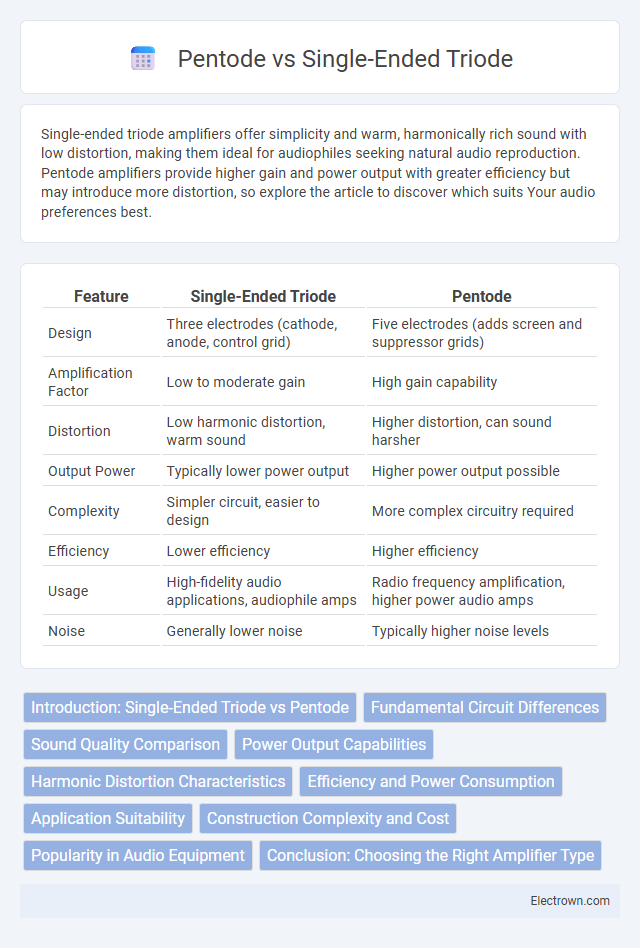Single-ended triode amplifiers offer simplicity and warm, harmonically rich sound with low distortion, making them ideal for audiophiles seeking natural audio reproduction. Pentode amplifiers provide higher gain and power output with greater efficiency but may introduce more distortion, so explore the article to discover which suits Your audio preferences best.
Table of Comparison
| Feature | Single-Ended Triode | Pentode |
|---|---|---|
| Design | Three electrodes (cathode, anode, control grid) | Five electrodes (adds screen and suppressor grids) |
| Amplification Factor | Low to moderate gain | High gain capability |
| Distortion | Low harmonic distortion, warm sound | Higher distortion, can sound harsher |
| Output Power | Typically lower power output | Higher power output possible |
| Complexity | Simpler circuit, easier to design | More complex circuitry required |
| Efficiency | Lower efficiency | Higher efficiency |
| Usage | High-fidelity audio applications, audiophile amps | Radio frequency amplification, higher power audio amps |
| Noise | Generally lower noise | Typically higher noise levels |
Introduction: Single-Ended Triode vs Pentode
Single-ended triode amplifiers deliver warm, rich sound with low distortion due to their simple design and inherent harmonic characteristics, making them ideal for audiophiles seeking natural audio reproduction. Pentode amplifiers offer higher power output and greater efficiency by utilizing multiple grids, but may introduce more complexity and potential distortion that requires careful circuit design. Understanding the tonal qualities and performance trade-offs between single-ended triode and pentode configurations helps you choose the best amplifier type for your audio preferences and system requirements.
Fundamental Circuit Differences
Single-ended triode amplifiers utilize a single triode valve in the output stage, known for simple circuitry and low distortion due to direct plate connection and minimal internal capacitance. Pentode amplifiers incorporate a screen grid and suppressor grid, reducing Miller effect and increasing gain and output power but introducing more complex circuit design and potential higher distortion. Triodes typically have lower output impedance, enhancing linearity, whereas pentodes offer greater power output at the cost of added circuit complexity and distortion management.
Sound Quality Comparison
Single-ended triode amplifiers deliver a warm, natural sound with rich harmonic overtones and smooth midrange, making them favored for audiophiles seeking musicality and organic tonality. Pentode amplifiers provide higher power output and greater efficiency, often producing a more dynamic and punchy sound with extended high-frequency response but can introduce more distortion and a less cohesive soundstage. Sound quality preference depends on listening environment and music genre, where triodes excel in subtle detail and texture, while pentodes offer robust volume and brightness.
Power Output Capabilities
Single-ended pentode amplifiers typically offer higher power output capabilities compared to single-ended triode designs due to their greater amplification factor and improved electron flow control. Triodes produce lower wattage but provide smoother harmonic distortion and a warmer sound, which some audiophiles prefer for musicality despite limited power. When selecting between them, your choice depends on whether you prioritize maximum output or tonal quality in your audio setup.
Harmonic Distortion Characteristics
Single-ended triode amplifiers exhibit predominantly even-order harmonic distortion, which contributes to a warm and musically pleasing sound signature. Pentode amplifiers tend to produce higher levels of odd-order harmonic distortion, resulting in a more aggressive and brighter tonal quality. When choosing between these designs, understanding your preference for harmonic texture can significantly influence your audio experience.
Efficiency and Power Consumption
Single-ended triodes typically exhibit lower efficiency due to their simpler construction and Class A operation, resulting in higher power consumption for the output they deliver. Pentodes achieve greater efficiency by utilizing multiple grid elements to reduce distortion and improve gain, allowing for more output power with less input current. Your choice between these tubes should consider that pentodes generally offer better power efficiency, which is crucial for applications demanding lower energy use without sacrificing performance.
Application Suitability
Single-ended triode (SET) amplifiers excel in high-fidelity audio applications requiring warm, natural sound with low distortion, making them ideal for audiophiles and intimate listening environments. Pentode amplifiers offer higher power output and greater efficiency, suited for applications demanding louder volumes and dynamic headroom, such as public address systems or guitar amplifiers. Your choice between single-ended triode and pentode depends on the balance you seek between sound purity and power needs.
Construction Complexity and Cost
Single-ended triode amplifiers feature a simpler construction with fewer components, resulting in lower manufacturing costs and easier maintenance. Pentode designs involve more complex circuitry, including additional grids that increase production expenses and require more precise assembly. The cost-effectiveness of triodes makes them attractive for budget-conscious audio setups, while pentodes justify higher prices with enhanced performance features.
Popularity in Audio Equipment
Single-ended triode (SET) amplifiers remain highly popular in high-end audio equipment for their warm, natural sound and simple design, which many audiophiles prefer for music reproduction. Pentode amplifiers, while less common in pure single-ended designs, are favored in scenarios requiring higher power output and greater efficiency, often seen in more versatile or budget-oriented audio devices. The enduring preference for SET amplifiers in audiophile communities stems from their harmonic richness and minimal distortion, making them a staple in boutique and luxury audio markets.
Conclusion: Choosing the Right Amplifier Type
Single-ended triode amplifiers deliver warm, natural sound with low distortion, ideal for purists seeking simplicity and musicality. Pentode amplifiers offer higher power output and greater efficiency, making them suitable for larger rooms and demanding speakers. Selecting the right amplifier depends on balancing desired sound character, listening environment, and amplifier specifications such as power rating and harmonic distortion.
single-ended triode vs pentode Infographic

 electrown.com
electrown.com